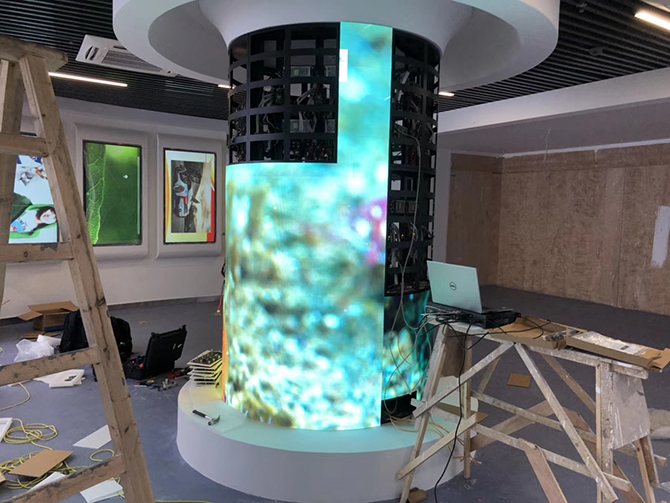Irregular-shaped LED screens refer to LED displays manufactured into highly regular shapes through special design.
This breaks the traditional limitation of displays being able to be assembled into squares or rectangles, allowing for various curved surfaces, arcs, and irregular free-form shapes, thus enhancing visual impact and artistic expression.
1. Curved Screen / Curved Surface Screen
This is the most common type of irregularly shaped screen and represents a transition from regular screens to irregularly shaped screens.
Features: It exhibits a certain curvature or arc, which can be an inward arc, an outward arc, or an S-shaped arc.
Advantages: Provides a better sense of surround sound and an immersive visual experience, conforming to the curvature of the human eye’s field of vision.
Applications: TV studios, stadiums, shopping mall atriums, brand showrooms, high-end conference centers.
2.Circular Screen
Features: Can be assembled into a complete circle or ring.
Advantages: Classic and eye-catching design, ideal as a visual focal point.
Applications: Hanging advertising screens in shopping malls, brand logos, stage backdrops, science and technology exhibition halls.
3. Cylindrical Screen
Features: A three-dimensional cylindrical shape with a 360° or partially curved design.
Classification:
Fully Transparent Cylindrical Screen: Large gaps are left between the units to maintain ventilation and light transmission without affecting the building’s lighting.
Conventional Cylindrical Screen: Units are tightly joined to form a complete cylindrical surface.
Applications: Shopping mall columns, central exhibition stands in showrooms, cylindrical stage landscaping.
4. Wave-shaped/Curved Irregular Screen
Features: Based on an arc shape, it creates an undulating, wave-like form, enhancing its dynamism and artistry.
Advantages: Dynamic design that greatly enhances the aesthetic appeal of a space.
Applications: Large building facades, flagship store entrances, theme parks (e.g., simulated ocean waves).

5. Spherical Screen
Features: Spliced together to form a spherical or hemispherical shape (geodesic dome).
Classification:
Inner Spherical Screen: Viewed from the inside, such as in planetariums and dome theaters.
Outer Spherical Screen: Viewed from the outside, such as in science museums, plaza landmarks, and stage effects.
Advantages: 360° unobstructed view, with a strong sense of technology and futurism.
6. Cube Screen / Magic Cube Screen
Features: Composed of multiple screen faces forming a cube structure, which can be four, five, or six sides fully enclosed.
Advantages: Strong sense of space; can be viewed from multiple angles; suitable for placement in the center of a plaza or exhibition hall.
Applications: Digital art installations, retail product displays, large event centers.
7. Irregularly Shaped Creative Screens
Features: This is the ultimate form of irregularly shaped screens, completely customized according to the designer’s creativity and client needs, with no fixed shape.
Examples: Simulating company logos (such as car brand logos), animal shapes, plant shapes, mechanical gears, abstract art structures, etc.
Applications: Brand marketing activities, theme parks, museums, large-scale press conference stages.
8. Strip Screens / Fence Screens
Features: The screen is long and narrow, resembling a fence.
Advantages: Does not obstruct the building’s view or lighting; flexible installation; often used as decoration and information display for building facades.
Applications: Building facades, shopping mall handrails, stage edges, airport information display strips.

